wipers MITSUBISHI I-MIEV 2011 Owners Manual
[x] Cancel search | Manufacturer: MITSUBISHI, Model Year: 2011, Model line: I-MIEV, Model: MITSUBISHI I-MIEV 2011Pages: 193, PDF Size: 12.2 MB
Page 10 of 193
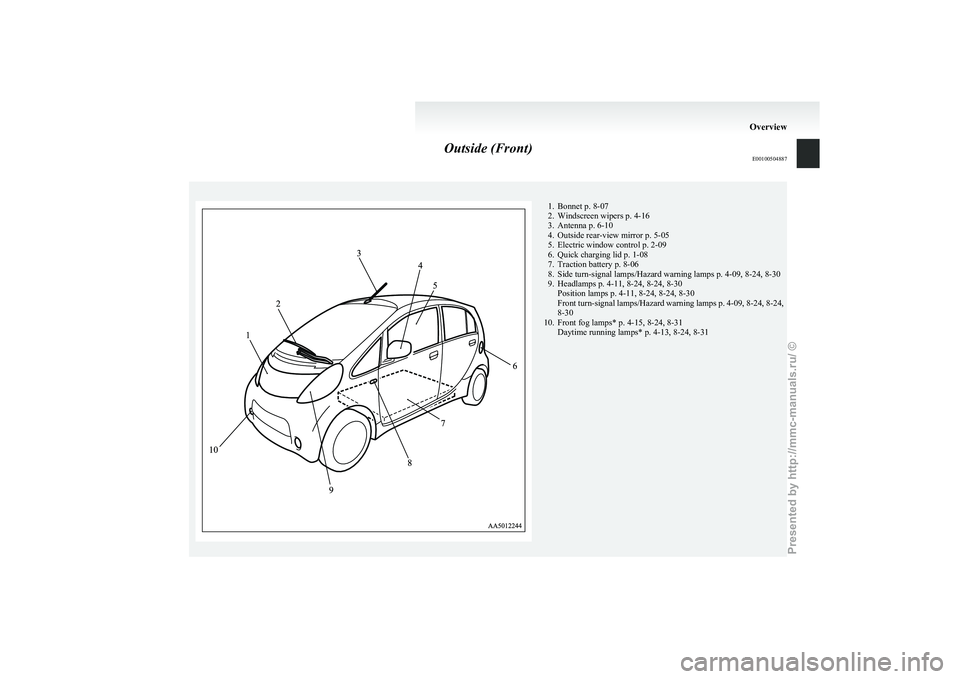
Outside (Front)
E00100504887 1. Bonnet p. 8-07
2.
Windscreen wipers p. 4-16
3. Antenna p. 6-10
4. Outside rear-view mirror p. 5-05
5. Electric window control p. 2-09
6. Quick charging lid p. 1-08
7. Traction battery p. 8-06
8. Side turn-signal lamps/Hazard warning lamps p. 4-09, 8-24, 8-30
9. Headlamps p. 4-11, 8-24, 8-24, 8-30 Position lamps p. 4-11, 8-24, 8-24, 8-30
Front turn-signal lamps/Hazard warning lamps p. 4-09, 8-24, 8-24,
8-30
10. Front fog lamps* p. 4-15, 8-24, 8-31 Daytime running lamps* p. 4-13, 8-24, 8-31 Overview
Presented by http://mmc-manuals.ru/ \251
Page 21 of 193
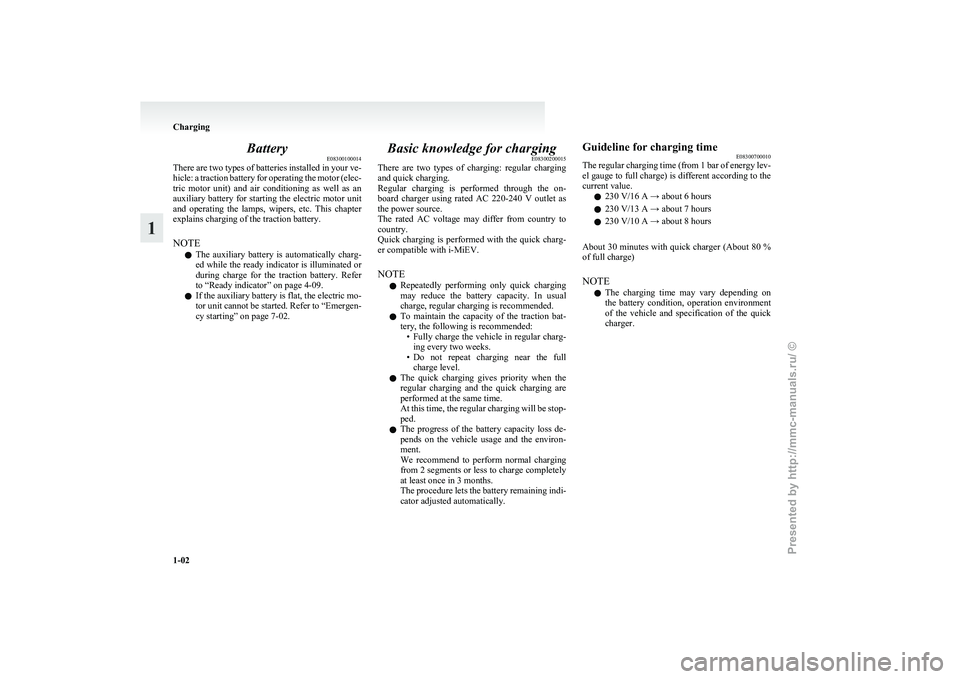
Battery
E08300100014
There
are two types of batteries installed in your ve-
hicle: a traction battery for operating the motor (elec-
tric motor unit) and air conditioning as well as an
auxiliary battery for starting the electric motor unit
and operating the lamps, wipers, etc. This chapter
explains charging of the traction battery.
NOTE
l The auxiliary battery is automatically charg-
ed while the ready indicator is illuminated or
during charge for the traction battery. Refer
to “Ready indicator” on page 4-09.
l If the auxiliary battery is flat, the electric mo-
tor unit cannot be started. Refer to “Emergen-
cy starting” on page 7-02. Basic knowledge for charging
E08300200015
There
are two types of charging: regular charging
and quick charging.
Regular charging is performed through the on-
board charger using rated AC 220-240 V outlet as
the power source.
The rated AC voltage may differ from country to
country.
Quick charging is performed with the quick charg-
er compatible with i-MiEV.
NOTE
l Repeatedly performing only quick charging
may reduce the battery capacity. In usual
charge, regular charging is recommended.
l To maintain the capacity of the traction bat-
tery, the following is recommended:
• Fully charge the vehicle in regular charg-ing every two weeks.
• Do not repeat charging near the full charge level.
l The quick charging gives priority when the
regular charging and the quick charging are
performed at the same time.
At this time, the regular charging will be stop-
ped.
l The progress of the battery capacity loss de-
pends on the vehicle usage and the environ-
ment.
We recommend to perform normal charging
from 2 segments or less to charge completely
at least once in 3 months.
The procedure lets the battery remaining indi-
cator adjusted automatically. Guideline for charging time
E08300700010
The
regular charging time (from 1 bar of energy lev-
el gauge to full charge) is different according to the
current value.
l 230 V/16 A → about 6 hours
l 230 V/13 A → about 7 hours
l 230 V/10 A → about 8 hours
About 30 minutes with quick charger (About 80 %
of full charge)
NOTE l The charging time may vary depending on
the battery condition, operation environment
of the vehicle and specification of the quick
charger. Charging
1-02
1
Presented by http://mmc-manuals.ru/ \251
Page 85 of 193

NOTE
l The
rear fog lamp is automatically turned off
when the headlamps or front fog lamps (if so
equipped) are turned off.
l To turn the rear fog lamp on again, turn the
knob once in the “ON” direction after turn-
ing on the headlamps. (Vehicle without front
fog lamps)
l To turn the rear fog lamp on again, turn the
knob twice in the “ON” direction after turn-
ing on the headlamps. (Vehicle with front
fog lamps) Wiper and washer switch
E00507101667 CAUTION
l
If
the washer is used in cold weather, the
washer fluid sprayed against the glass
may freeze, which may hinder visibility.
Warm the glass with the defroster or rear
window demister before using the washer.
Windscreen wipers E00516900534
The windscreen wipers can be operated with the
electric
motor switch in the “ON” or “ACC” posi-
tion.
If the blades are frozen to the windscreen or rear
window, do not operate the wipers until the ice has
melted and the blades are freed, otherwise the wip-
er motor may be damaged. MIST- Misting function
The wipers will operate once.
OFF- Off
INT- Intermittent (Speed sensitive)
LO- Slow
HI- Fast
To adjust intermittent intervals
With
the lever in the “INT” (speed-sensitive) posi-
tion, the intermittent intervals can be adjusted by
turning the knob (A). 1- Fast
2-
Slow
NOTE l The speed-sensitive-operation function of the
windscreen wipers can be deactivated.
For further information, we recommend you
to consult a MITSUBISHI MOTORS Author-
ized Service Point. Instruments and controls
4-16
4
Presented by http://mmc-manuals.ru/ \251
Page 86 of 193
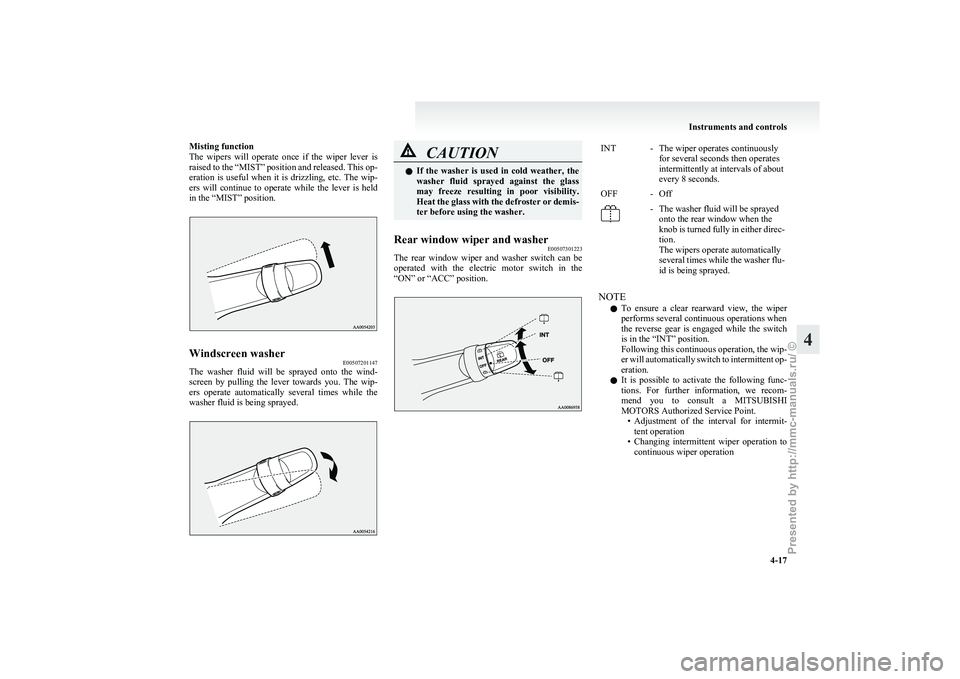
Misting function
The
wipers will operate once if the wiper lever is
raised to the “MIST” position and released. This op-
eration is useful when it is drizzling, etc. The wip-
ers will continue to operate while the lever is held
in the “MIST” position. Windscreen washer
E00507201147
The washer fluid will be sprayed onto the wind-
screen
by pulling the lever towards you. The wip-
ers operate automatically several times while the
washer fluid is being sprayed. CAUTION
l
If
the washer is used in cold weather, the
washer fluid sprayed against the glass
may freeze resulting in poor visibility.
Heat the glass with the defroster or demis-
ter before using the washer.
Rear window wiper and washer E00507301223
The rear window wiper and washer switch can be
operated
with the electric motor switch in the
“ON” or “ACC” position. INT - The wiper operates continuously
for several seconds then operates
intermittently at intervals of about
every 8 seconds.
OFF - Off - The washer fluid will be sprayed
onto the rear window when the
knob
is turned fully in either direc-
tion.
The wipers operate automatically
several times while the washer flu-
id is being sprayed.
NOTE l To
ensure a clear rearward view, the wiper
performs several continuous operations when
the reverse gear is engaged while the switch
is in the “INT” position.
Following this continuous operation, the wip-
er will automatically switch to intermittent op-
eration.
l It is possible to activate the following func-
tions. For further information, we recom-
mend you to consult a MITSUBISHI
MOTORS Authorized Service Point.
• Adjustment of the interval for intermit-tent operation
• Changing intermittent wiper operation to continuous wiper operation Instruments and controls
4-17 4
Presented by http://mmc-manuals.ru/ \251
Page 87 of 193
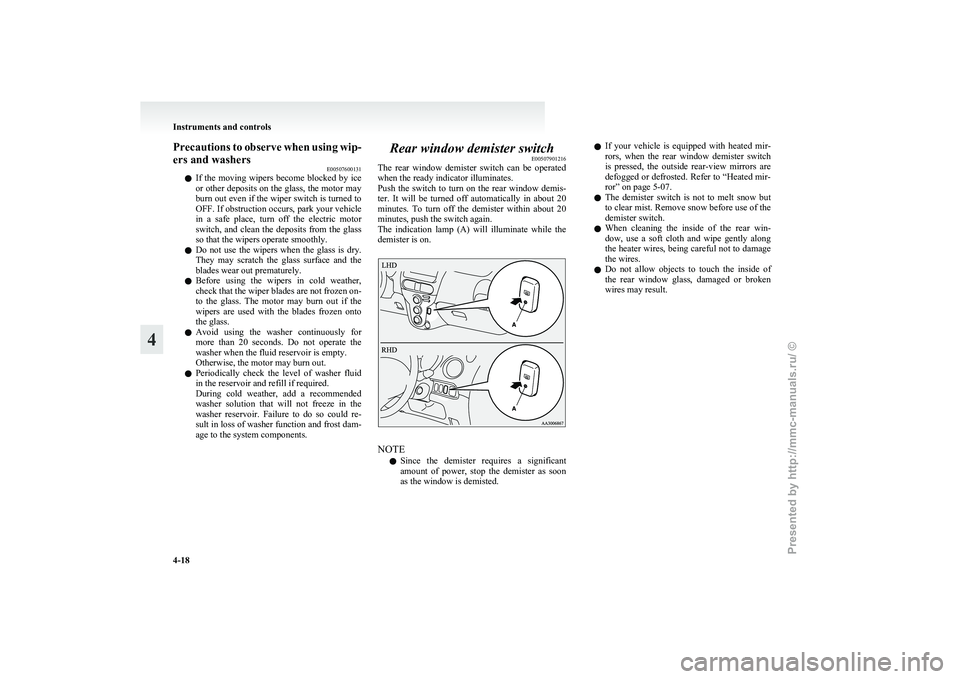
Precautions to observe when using wip-
ers and washers
E00507600131
l If
the moving wipers become blocked by ice
or other deposits on the glass, the motor may
burn out even if the wiper switch is turned to
OFF. If obstruction occurs, park your vehicle
in a safe place, turn off the electric motor
switch, and clean the deposits from the glass
so that the wipers operate smoothly.
l Do not use the wipers when the glass is dry.
They may scratch the glass surface and the
blades wear out prematurely.
l Before using the wipers in cold weather,
check that the wiper blades are not frozen on-
to the glass. The motor may burn out if the
wipers are used with the blades frozen onto
the glass.
l Avoid using the washer continuously for
more than 20 seconds. Do not operate the
washer when the fluid reservoir is empty.
Otherwise, the motor may burn out.
l Periodically check the level of washer fluid
in the reservoir and refill if required.
During cold weather, add a recommended
washer solution that will not freeze in the
washer reservoir. Failure to do so could re-
sult in loss of washer function and frost dam-
age to the system components. Rear window demister switch
E00507901216
The
rear window demister switch can be operated
when the ready indicator illuminates.
Push the switch to turn on the rear window demis-
ter. It will be turned off automatically in about 20
minutes. To turn off the demister within about 20
minutes, push the switch again.
The indication lamp (A) will illuminate while the
demister is on. NOTE
l Since
the demister requires a significant
amount of power, stop the demister as soon
as the window is demisted. l
If
your vehicle is equipped with heated mir-
rors, when the rear window demister switch
is pressed, the outside rear-view mirrors are
defogged or defrosted. Refer to “Heated mir-
ror” on page 5-07.
l The demister switch is not to melt snow but
to clear mist. Remove snow before use of the
demister switch.
l When cleaning the inside of the rear win-
dow, use a soft cloth and wipe gently along
the heater wires, being careful not to damage
the wires.
l Do not allow objects to touch the inside of
the rear window glass, damaged or broken
wires may result. Instruments and controls
4-18
4
Presented by http://mmc-manuals.ru/ \251
Page 146 of 193
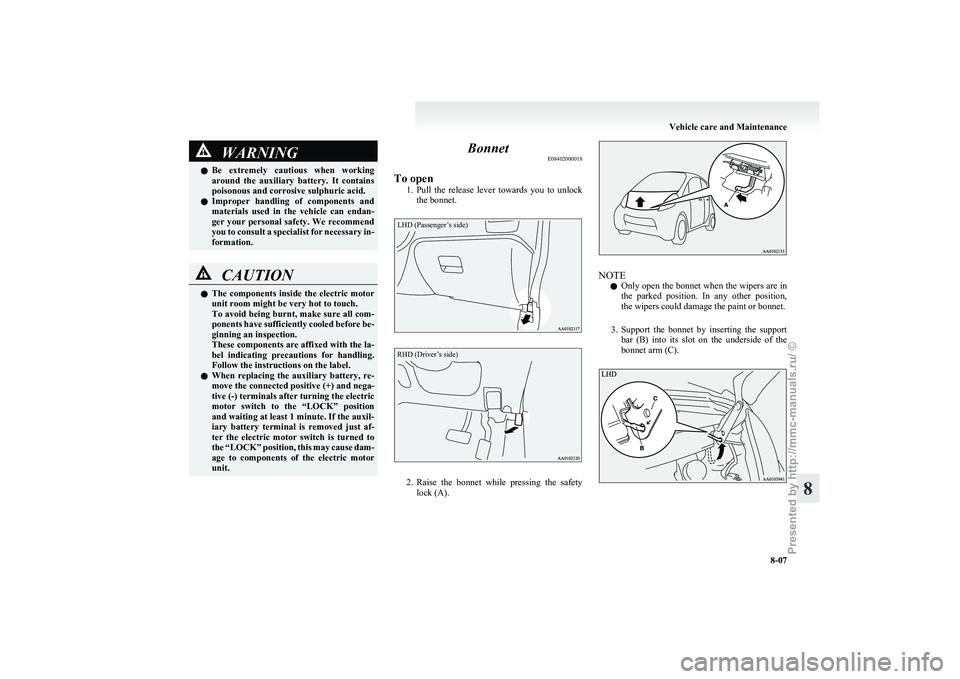
WARNING
l Be extremely cautious when working
around the auxiliary battery. It contains
poisonous and corrosive sulphuric acid.
l Improper handling of components and
materials used in the vehicle can endan-
ger your personal safety. We recommend
you to consult a specialist for necessary in-
formation. CAUTION
l
The
components inside the electric motor
unit room might be very hot to touch.
To avoid being burnt, make sure all com-
ponents have sufficiently cooled before be-
ginning an inspection.
These components are affixed with the la-
bel indicating precautions for handling.
Follow the instructions on the label.
l When replacing the auxiliary battery, re-
move the connected positive (+) and nega-
tive (-) terminals after turning the electric
motor switch to the “LOCK” position
and waiting at least 1 minute. If the auxil-
iary battery terminal is removed just af-
ter the electric motor switch is turned to
the “LOCK” position, this may cause dam-
age to components of the electric motor
unit. Bonnet
E08402000018
To open 1. Pull
the release lever towards you to unlock
the bonnet.
LHD (Passenger’s side)
RHD (Driver’s side) 2. Raise
the bonnet while pressing the safety
lock (A). NOTE
l Only
open the bonnet when the wipers are in
the parked position. In any other position,
the wipers could damage the paint or bonnet.
3. Support the bonnet by inserting the support bar (B) into its slot on the underside of the
bonnet arm (C). Vehicle care and Maintenance
8-07 8
Presented by http://mmc-manuals.ru/ \251
Page 156 of 193

CAUTION
l
Observe permissible maximum speed for
your snow tyres and the legal speed limit.
NOTE l The
laws and regulations concerning snow
tyres (driving speed, required use, type, etc.)
vary. Find out and follow the laws and regu-
lations in the area you intend to drive.
l If flange nuts are used on your vehicle,
change to tapered nuts when steel wheels are
used.
Tyre chains E08403400019
If tyre chains have to be used, ensure that they are
fitted
only on the drive wheels (rear) in accordance
with the manufacturer’s instructions.
Use only tyre chains which are designed for use
with the tyres mounted on the vehicle: use of the in-
correct size or type of chain could result in damage
to the vehicle body.
Contact a MITSUBISHI MOTORS Authorized
Service Point before putting on tyre chains. The
max. chain height is as follows. Tyre size Wheel size Max chain
height[mm]
175/55R15 77V 15 x 5 J 14 mm When driving with tyre chains on the tyres, do not
drive
faster than 50 km/h (30 mph). When you
reach roads that are not covered in snow, immedi-
ately remove the tyre chains. CAUTION
l
Practice
fitting the chains before you
need them. Don’t expect help from other
people in the cold.
l Choose a clear straight stretch of road
where you can pull over and still be seen
while you are fitting the chains.
l Do not fit chains before you need them.
This will wear out your tyres and the
road surface.
l After driving around 100-300 metres,
stop and retighten the chains.
l Drive carefully and do not exceed
50 km/h (30 mph). Remember that pre-
venting accidents is not the purpose of
tyre chains.
l An aluminium wheel can be damaged by
a tyre chain while driving. When fitting a
tyre chain on an aluminium wheel, take
care that no part of the chain and fitting
can be brought into contact with the wheel.
l When installing or removing the tyre
chains, take care that hands and other
parts of your body are not injured by the
sharp edges of the vehicle body.
NOTE l The
laws and regulations concerning the use
of tyre chains vary. Always follow local laws
and regulations.
In most countries, it is prohibited by law to
use tyre chains on roads without snow. Wiper blades
E08403500010
If
the blades are frozen to the windscreen or rear
window, do not operate the wipers until the ice has
melted and the blades are freed, otherwise the wip-
er motor may be damaged.
NOTE
l When replacing the front wiper with a wiper
for use in cold regions, it is necessary to ad-
just the washer nozzle spray positions. Al-
ways contact your MITSUBISHI MOTORS
Authorized Service Point when replacing the
front wiper with a wiper for use in cold re-
gions.
l When removing snow and frost, be careful
not to damage the washer nozzles (A) attach-
ed to the wiper arm. Wiper blade rubber replacement
Windscreen wiper blades
1.
Lift the wiper arm off the windscreen.
2. Pull the wiper blade until its stopper (A) dis- engages from the hook (B) as indicated direc- Vehicle care and Maintenance
8-17 8
Presented by http://mmc-manuals.ru/ \251
Page 185 of 193

Replacement 8-31
Switch 4-15
Front room lamp Bulb capacity
8-24
Front seat 3-03
Front turn-signal lamps Bulb capacity 8-24
Replacement 8-30
Fuel Modification/alterations to the electrical sys-
tems 04
Fuses 8-20
Fusible links 8-20
GGauges 4-02,4-08
General maintenance
8-19
General vehicle data 9-03
Genuine parts 04
Glove box 6-14
HHazard warning flasher switch 4-15
Hazard warning indication lamps
4-09
Head restraints 3-07
Headlamp levelling switch 4-13
Headlamps Bulb capacity 8-24
Headlamp flasher 4-13
Replacement 8-24,8-28,8-29
Switch 4-11
Heat Cautions and actions to deal with intense
heat 05
Heated mirror 5-07
Heated seat 3-04
High-beam indication lamp 4-09 High-mounted stop lamp
Bulb capacity
8-24
Replacement 8-34
Hinges and latches lubrication 8-19
Horn switch 4-19
Hot water heater fluid 8-09,9-07
I i-MiEV 02
Cruising range 02
Main features 02
Traction battery
02
If the vehicle breaks down 7-02
Indication and warning lamps 4-08
Indication lamps 4-09
Inside rear-view mirror 5-05
Inspection and maintenance following rough road
operation 5-12
Instruments 4-02
Intense cold Cautions and actions 06
Intense heat Cautions and actions 05
Interior lamps 6-12
J Jump starting (Emergency starting) 7-02
K Keyless entry system 2-03
Keys 2-02
L Labeling 9-02
Lamp monitor buzzer
4-12 Lamps (headlamps, fog lamp, etc.) auto-cutout func-
tion 4-12
Licence plate lamps
Bulb capacity
8-24
Replacement 8-34
Low voltage electrical system 9-04
Lubricants 9-07
M Map lamps 6-12,6-13
Bulb capacity
8-24
Meter illumination control 4-03,4-06
Mirror Inside rear-view mirror 5-05
Outside rear-view mirrors 5-05
Modification/alterations to the electrical sys-
tems 04
O Odometer 4-03,4-04
Oil
Transmission oil 9-07
Operation under adverse driving conditions
7-12
Outside rear-view mirrors 5-05
P Parking 5-04
Parking brake 5-03
Position lamps Bulb capacity
8-24
Indication lamp 4-09
Replacement 8-30
Power down warning lamp 4-11
Precautions to observe when using wipers and wash-
ers 4-18
Pregnant women restraint 3-10 Alphabetical index
2
Presented by http://mmc-manuals.ru/ \251